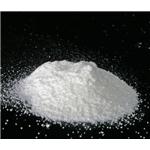Lithium triethylborohydride is the organoboron compound with the formula LiEt3BH. Commonly referred to as LiTEBH or Superhydride, it is a powerful reducing agent used in organometallic and organic chemistry. It is a colorless or white liquid but is typically marketed and used as a THF solution. The related reducing agent sodium triethylborohydride is commercially available as toluene solutions.
LiBHEt3 is a stronger reducing agent than lithium borohydride and lithium aluminium hydride.
colorless to light grey cloudy solution
LiTEBH can be used as a reagent:
- To reduce alkyl halides to alkanes via dehydrogenation reactions.
- For the selective reduction of epoxides to Markovnikov alcohols.
- To reduce tosylates or mesylates primary alcohols to hydrocarbons.
- For reductive cyclization reactions for the preparation of useful intermediates.
- In the synthesis of hepta(manno-3-deoxy-6-O-t-butyldimethylsilyl)-β-cyclodextrin by reduction of hepta(manno-2,3-anhydro-6-O-t-butyldimethylsilyl)-β-cyclodextrin.
- For hydrodefluorination of C-F bonds using Ni catalyst.
- To prepare alkynyl alcohols from cleavage of cyclic keto-vinyl triflates.
- In the stereoselective reduction of bicyclic imides, isoquinolines, and pyridines.
- To prepare tungsten and molybdenum hydride complexes.
Powerful and selective reducing agent.
As a reducing agentLithium triethylborohydride is used as a powerful reducing agent in organic synthesis for the conversion of carbonyl compounds to alcohols. It is also used in the preparation of alkynyl alcohols from the cleavage of cyclic keto-vinyl triflates. It is also used in the reduction of esters and lactones to alcohol and diol respectively. Further, it is used to prepare 1-methylcyclohexanol and 1,4-butanediol from 1,2-epoxybutane and gamma-butyrolactone respectively. It is also utilized for reductive cleavage of mesylates and tosylates in synthetic organic chemistry.
LiBHEt3 is prepared by the reaction of lithium hydride (LiH) and triethylborane (Et3B) in tetrahydrofuran (THF):
LiH + Et3B → LiEt3BH
Its THF solutions are stable indefinitely in the absence of moisture and air.
Lithium Triethylborohydride (LiTEBH) is widely used as a powerful and selective reducing agent that shows super hydride activity in organic synthesis.
LiTEBH can be used as a reagent:
To reduce alkyl halides to alkanes via dehydrogenation reactions.
For the selective reduction of epoxides to Markovnikov alcohols.
To reduce tosylates or mesylates primary alcohols to hydrocarbons.
For reductive cyclization reactions for the preparation of useful intermediates.
In the synthesis of hepta(manno-3-deoxy-6-O-t-butyldimethylsilyl)-β-cyclodextrin by reduction of hepta(manno-2,3-anhydro-6-O-t-butyldimethylsilyl)-β-cyclodextrin.
For hydrodefluorination of C-F bonds using Ni catalyst.
To prepare alkynyl alcohols from cleavage of cyclic keto-vinyl triflates.
In the stereoselective reduction of bicyclic imides, isoquinolines, and pyridines.
To prepare tungsten and molybdenum hydride complexes.
Super-Hydride? solution (Lithium triethylborohydride or LiTEBH) is widely used as a powerful and selective reducing agent that shows super hydride activity in organic synthesis.
Moisture sensitive. Air sensitive. Incompatible with water and strong oxidizing agents.
Tamang, S.; Kim, K.; Choi, H.; Kim, Y.; Jeong, S. Synthesis of colloidal InSb nanocrystals via in situ activation of InCl3. Dalton Trans. 2015, 44 (38), 16923-16928.
Kandapallil, B.; Colborn, R. E.; Bonitatibus, P. J.; Johnson, F. Synthesis of high magnetization Fe and FeCo nanoparticles by high temperature chemical reduction. J. Magn. Magn. Mater. 2015, 378, 535-538.


